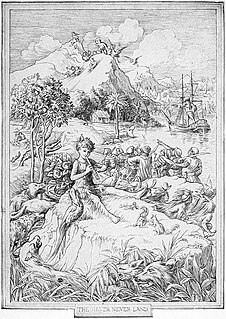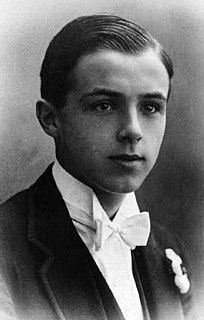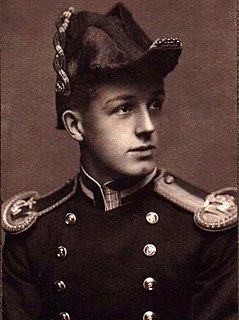
Captain James Hook is a fictional character, the main antagonist of J. M. Barrie's 1904 play Peter Pan; or, the Boy Who Wouldn't Grow Up and its various adaptations, in which he is Peter Pan's archenemy. The character is a pirate captain of the brig Jolly Roger. His two principal fears are the sight of his own blood and the crocodile who pursues him after eating the hand cut off by Pan. An iron hook replaced his severed hand, which gave the pirate his name.

Sir James Matthew Barrie, 1st Baronet, was a Scottish novelist and playwright, best remembered as the creator of Peter Pan. He was born and educated in Scotland and then moved to London, where he wrote a number of successful novels and plays. There he met the Llewelyn Davies boys, who inspired him to write about a baby boy who has magical adventures in Kensington Gardens, then to write Peter Pan, or The Boy Who Wouldn't Grow Up, a 1904 West End "fairy play" about an ageless boy and an ordinary girl named Wendy who have adventures in the fantasy setting of Neverland.

Neverland is a fictional island featured in the works of J. M. Barrie and those based on them. It is an imaginary faraway place where Peter Pan, Tinker Bell, Captain Hook, the Lost Boys, and some other imaginary beings and creatures live.

Tinker Bell is a fictional character from J. M. Barrie's 1904 play Peter Pan and its 1911 novelisation Peter and Wendy. She has appeared in a variety of film and television adaptations of the Peter Pan stories, in particular the 1953 animated Walt Disney picture Peter Pan. She also appears in the official 2006 sequel Peter Pan in Scarlet by Geraldine McCaughrean commissioned by Great Ormond Street Hospital as well as the "Peter and the Starcatchers" book series by Ridley Pearson and Dave Barry.

Arthur Rackham was an English book illustrator. He is recognised as one of the leading figures during the Golden Age of British book illustration. His work is noted for its robust pen and ink drawings, which were combined with the use of watercolour, a technique he developed due to his background as a journalistic illustrator.
Peter Pan is a fictional boy who refuses to grow up, created by Scottish author J. M. Barrie and first appearing in Barrie's 1902 novel The Little White Bird.

Michael Llewelyn Davies was – along with his four brothers – the inspiration for J. M. Barrie's characters Peter Pan, the Darling brothers, and the Lost Boys. Late in life, his only surviving brother Nico described him as "the cleverest of us, the most original, the potential genius." He died in ambiguous circumstances, drowning with a close friend – and possible lover – just short of his 21st birthday. He was a first cousin of English writer Daphne du Maurier.

Peter Llewelyn Davies MC was the middle of five sons of Arthur and Sylvia Llewelyn Davies, one of the Llewelyn Davies boys befriended and later informally adopted by J. M. Barrie. Barrie publicly identified him as the source of the name for the title character in his 1904 play Peter Pan, or The Boy Who Wouldn't Grow Up. This public identification as "the original Peter Pan" plagued Davies throughout his life, which ended in suicide.

John "Jack" Llewelyn Davies was the second eldest of the Llewelyn Davies boys befriended by Peter Pan creator J. M. Barrie, and one of the inspirations for the boy characters in the story of Peter Pan. He served in the Royal Navy during World War I. He was the first cousin of the English writer Daphne du Maurier.

Henry Justice Ford (1860–1941) was a prolific and successful English artist and illustrator, active from 1886 through to the late 1920s. Sometimes known as H. J. Ford or Henry J. Ford, he came to public attention when he provided the numerous beautiful illustrations for Andrew Lang's Fairy Books, which captured the imagination of a generation of British children and were sold worldwide in the 1880s and 1890s.

Mr. Smee is a fictional character who serves as Captain Hook's boatswain in J. M. Barrie's 1904 play Peter Pan, or the Boy Who Wouldn't Grow Up and 1911 novel Peter and Wendy.

Peter Pan in Scarlet (2006) is a novel by British author Geraldine McCaughrean. It is the official sequel to J. M. Barrie's Peter and Wendy (1911), as it was authorised by Great Ormond Street Hospital, which was granted all rights to the characters and original writings by Barrie in 1929. McCaughrean was selected in 2004 following a competition in which novelists were invited to submit a sample chapter and plot outline for a sequel. Set in 1926, the book continues the story of the Lost Boys, the Darling family, and Peter Pan, during the reign of George V and following World War I.

Peter Pan is a fictional character created by Scottish novelist and playwright J. M. Barrie. A free-spirited and mischievous young boy who can fly and never grows up, Peter Pan spends his never-ending childhood having adventures on the mythical island of Neverland as the leader of the Lost Boys, interacting with fairies, pirates, mermaids, Native Americans, and occasionally ordinary children from the world outside Neverland.
The Davies boys were the inspiration for J. M. Barrie's Peter Pan, in which several of the characters were named after them. They were the sons of Sylvia (1866–1910) and Arthur Llewelyn Davies (1863–1907). Their mother was a daughter of French-born cartoonist and writer George du Maurier and sister of actor Gerald du Maurier, whose daughter was author Daphne du Maurier. Their father was a son of preacher John Llewelyn Davies, and brother of suffragist Margaret Llewelyn Davies.

Arthur Llewelyn Davies was an English barrister, but is best known as the father of the boys who were the inspiration for the stories of Peter Pan by J. M. Barrie.
The Little White Bird is a novel by the Scottish writer J. M. Barrie, ranging in tone from fantasy and whimsy to social comedy with dark, aggressive undertones. It was published in November 1902, by Hodder & Stoughton in the UK and Scribner's in the US. The book attained prominence and longevity thanks to several chapters written in a softer tone than the rest of the book, which introduced the character and mythology of Peter Pan. In 1906, those chapters were published separately as a children's book, Peter Pan in Kensington Gardens.
The works of J. M. Barrie about Peter Pan feature many characters. The numerous adaptations and sequels to those stories feature many of the same characters, and introduce new ones. Most of these strive for continuity with Barrie's work, developing a fairly consistent cast of characters living in Neverland and the real-world settings of Barrie's stories.

Peter Pan; or, the Boy Who Wouldn't Grow Up or Peter and Wendy, often known simply as Peter Pan, is a work by J. M. Barrie, in the form of a 1904 play and a 1911 novel. Both versions tell the story of Peter Pan, a mischievous yet innocent little boy who can fly, and has many adventures on the island of Neverland that is inhabited by mermaids, fairies, Native Americans, and pirates. The Peter Pan stories also involve the characters Wendy Darling and her two brothers John and Michael, Peter's fairy Tinker Bell, the Lost Boys, and the pirate Captain Hook. The play and novel were inspired by Barrie's friendship with the Llewelyn Davies family. Barrie continued to revise the play for years after its debut until publication of the play script in 1928.

The statue of Peter Pan is a 1912 bronze sculpture of J. M. Barrie's character Peter Pan. It was commissioned by Barrie and made by Sir George Frampton. The original statue is displayed in Kensington Gardens in London, to the west of The Long Water, close to Barrie's former home on Bayswater Road. Barrie's stories were inspired in part by the gardens: the statue is at the place where Peter Pan lands in Barrie's 1902 book The Little White Bird after flying out of his nursery. Six other casts made by Frampton have been erected in other places around the world.
















